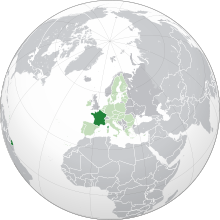
Back تاريخ اليهود في فرنسا Arabic История на евреите във Франция Bulgarian Židé ve Francii Czech Geschichte der Juden in Frankreich German Historia de los judíos en Francia Spanish Ranskan juutalaiset Finnish Histoire des Juifs en France French יהדות צרפת HE Yahudi-Prancis ID Storia degli ebrei in Francia Italian
 | |
| Total population | |
| Core Jewish population: 480,000–550,000[1][2][3][4][5] Enlarged Jewish population (includes non-Jewish relatives of Jews): 600,000[6][7] | |
| Regions with significant populations | |
| Languages | |
| Traditional Jewish languages Hebrew, Yiddish, Ladino, and other Jewish languages (most endangered and some now extinct) Liturgical languages Hebrew and Aramaic Predominant spoken languages French, Hebrew, Judeo-Arabic, Yiddish, and Russian | |
| Religion | |
| Judaism or no religion | |
| Related ethnic groups | |
| Sephardi Jews, Mizrahi Jews, Ashkenazi Jews, other ethnic divisions |
| Part of a series on |
| Jews and Judaism |
|---|
The history of the Jews in France deals with Jews and Jewish communities in France since at least the Early Middle Ages. France was a centre of Jewish learning in the Middle Ages, but persecution increased over time, including multiple expulsions and returns. During the French Revolution in the late 18th century, on the other hand, France was the first European country to emancipate its Jewish population. Antisemitism still occurred in cycles and reached a high in the 1890s, as shown during the Dreyfus affair, and in the 1940s, under Nazi occupation and the Vichy regime.
Before 1919, most French Jews lived in Paris, with many being very proud to be fully assimilated into French culture, and they comprised an upscale subgroup.[citation needed] A more traditional Judaism was based in Alsace-Lorraine, which was recovered by The German Empire in 1871 and taken by France in 1918 following World War I.[citation needed] In addition, numerous Jewish refugees and immigrants came from Russia and eastern and central Europe in the early 20th century, changing the character of French Judaism in the 1920s and 1930s. These new arrivals were much less interested in assimilation into French culture. Some supported such new causes as Zionism, the Popular Front and communism, the latter two being popular among the French political left.[citation needed]
During World War II, the Vichy government collaborated with Nazi occupiers to deport a large number of both French Jews and foreign Jewish refugees to concentration camps.[8] By the war's end, 25% of the Jewish population of France had been murdered in the Holocaust, though this was a lower proportion than in most other countries under Nazi occupation.[9][10]
In the 21st century, France has the largest Jewish population in Europe and the third-largest Jewish population in the world (after Israel and the United States). The Jewish community in France is estimated to number 480,000–550,000, depending in part on the definition being used. French Jewish communities are concentrated in the metropolitan areas of Paris, which has the largest Jewish population among all European cities (277,000),[11] Marseille, with a population of 70,000, Lyon, Nice, Strasbourg and Toulouse.[12]
The majority of French Jews in the 21st century are Sephardi and Mizrahi North African Jews, many of whom (or their parents) emigrated from former French colonies of North Africa after those countries gained independence in the 1950s and 1960s. They span a range of religious affiliations, from the ultra-Orthodox Haredi communities to the large segment of Jews who are entirely secular and who often marry outside the Jewish community.[13]
Approximately 200,000 French Jews live in Israel. Since 2010 or so, more have been making aliyah in response to rising antisemitism in France.[14]
- ^ "Jewish Population of the World". Jewish Virtual Library. 2012. Archived from the original on 24 January 2017. Retrieved 29 January 2014.
- ^ Serge Attal (14 January 2013). "French Jews fear anti-Semitism will destroy community". Times of Israel. Archived from the original on 18 January 2013. Retrieved 5 February 2020.
- ^ Joe Berkofsky (25 March 2012). "More Than One Quarter of Jews in France Want To Leave, Poll Finds". Jewish Federations. Archived from the original on 2 June 2013. Retrieved 5 February 2013.
- ^ Gil Yaron (22 March 2012). "Fears of Anti-Semitism: More and More French Jews Emigrating to Israel". Der Spiegel. Spiegel. Archived from the original on 16 December 2012. Retrieved 5 February 2013.
- ^ France info (19 March 2012). "La communauté juive de France compte 550.000 personnes, dont 25.000 à Toulouse" (in French). Archived from the original on 13 January 2015. Retrieved 9 January 2015.
- ^ John Irish and Guillaume Serries (March 2012). "Gunman attacks Jewish school in France, four killed". Reuters. Retrieved 5 February 2013.
- ^ Jim Maceda (19 March 2012). "Four shot dead at Jewish school in France; gun used in earlier attacks". NBC News. Archived from the original on 2 February 2014. Retrieved 5 February 2013.
- ^ Cite error: The named reference
USHMMwas invoked but never defined (see the help page). - ^ "Le Bilan de la Shoah en France [Le régime de Vichy]". bseditions.fr. Archived from the original on 14 May 2021. Retrieved 8 June 2015.
- ^ Yad Vashem [1] Archived 11 October 2017 at the Wayback Machine
- ^ "Jewish world population 2016" (PDF). Archived (PDF) from the original on 28 October 2018. Retrieved 23 April 2021.
- ^ "France". World Jewish Congress. Archived from the original on 23 October 2014.
- ^ "France : Un portrait de la population juive". Religioscope. Archived from the original on 24 September 2015. Retrieved 26 February 2017.
- ^ "Jews are leaving France in record numbers amid rising antisemitism and fears of more Isis-inspired terror attacks". The Independent. 25 January 2016. Archived from the original on 7 May 2022. Retrieved 29 August 2017.